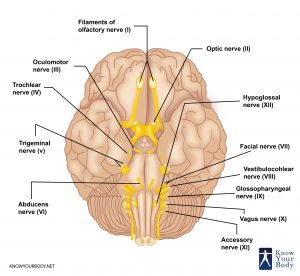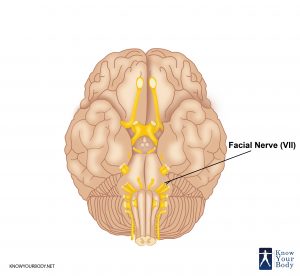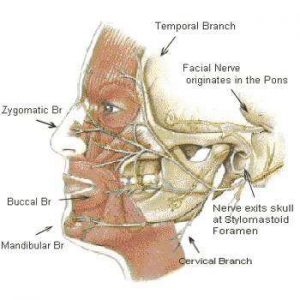What is a Facial Nerve?
The Facial Nerve, also known as the Cranial Nerve VII or the CN7 is the pathway of nerves that control the facial expressions. The facial nerves are composed of almost 10,000 neurons. Out of these, 7000 neurons are responsible for the various facial expressions we get to see in an individual. But the role of the facial nerve does not simply end at governing our facial expressions. The facial nerves are also responsible for conveying the different taste sensations from our tongue and oral cavities to our brains.
Facial Nerve Location and Origin
The course of the facial nerves of a human being is extremely complex and digressing. There are several branches of these facial nerves, each which perform a different type of function; sensory, parasympathetic or motor functions.
The course of the facial nerves can be divided into two large segments:
• Intracranial, which is the course of the facial nerves through the cranium itself.
• Extracranial, which is the course of the facial nerves outside the cranial cavity, along with the face and the neck.
The branches of the nerve which are responsible for the various facial expressions are:
1. Temporal branch
2. Zygomatic branch
3. Cervical branch
4. Buccal branch
5. Marginal mandibular branch
Facial Nerve Functions
There are three basic functions of the facial nerves; these are the Motor Function, the Parasympathetic Function, and the Sensory Function.
Motor Function
The 5 branches of the facial nerves are responsible for the various functions of facial expression of a human being. These are:
1. Temporal branch: which innervates the frontalis, corrugator supercilii, and the orbicularis oculi (the area around the head and eyes)
2. Zygomatic branch: which innervates the orbicularis oculi (the eye socket area)
3. Buccal branch: which innervates the orbicularis oris, buccinators and the zygomaticus muscles (the area around the mouth and jaw)
4. Marginal mandibular branch: which innervates the mentalis muscle ( the area around the lower jaw)
5. Cervical branch: which innervates the platysma
Sensory Functions
A special branch of the facial nerve known as the chorda tempani branch is responsible for innervating the anterior 2/3rd portion of the tongue and the mouth cavity. General sensation of this 2/3rd part of the tongue is supplied by various fibers of the facial nerve.
Parasympathetic Functions
The parasympathetic functions of the facial nerve are carried out by two main branches of facial nerves. These are the greater petrosal branch and the chorda tympani branch.
Structure and Anatomy of Facial Nerve
The facial nerve is also known as the seventh cranial nerve. This nerve conveys information to the tongue and the mouth. Approximately two-thirds of the tongues tip is served by the CN7 facial nerve. This facial nerve extends from the pons and the medulla of the brain stem. The nerve innervates the facial muscles, controlling and producing facial expressions.
The CN7 facial nerve splits into several branches.
The greater petrosal nerve is responsible for serving the lacrimal gland, the nasal cavity as well as other cavities in the skull (the sphenoid, frontal, ethmoid sinus, and maxillary).
One of the branches of the facial nerve serves the stapedius muscle, which is a muscle situated in the inner ear.
Another facial nerve branch known as the chorda tempani branch innervates the sublingual glands and the submandibular glands, which are the salivary glands and the glands under the floor of the mouth. These branches of nerves convey taste sensations from the tip of the tongue to the brain.
Facial Nerve Origin
The facial nerve is the 7th cranial nerve (CN7) which emerges from the brainstem in between the medulla and the pons.
Facial Nerve Insertion and Branches
The facial nerve of the CN7 passes through the parotid gland, to form the parotid plexus. Then, it splits into five branches, innervating the various muscles of facial expressions. These are the:
1. Temporal
2. Buccal
3. Cervical
4. Zygomatic
5. Marginal mandibular
Facial Nerve Pictures
Clinical Complications for Facial Nerves
The different types of facial nerve disorder are:
1. Bell’s Palsy: this is the most common type of facial nerve disorder affecting about 80% of patients. The signs and symptoms of Bell’s Palsy have been listed above.
2. Ramsay Hunt Syndrome: this type of facial nerve disorder has more severe symptoms. This facial nerve disorder is caused by a virus in the facial nerve, and can blisters on the ears, mouth as well as facial weakness.
3. Lyme disease: this is a common bacterial infection caused when a patient is bitten by an infected tick. Patients will have many symptoms such as rash, fever, headache, weakness, and facial paralysis.
Signs and Symptoms
The facial nerves of a human being have a wide array of functions, as discussed above. When there is any damage to these facial nerves, there can be a lot of types of signs and symptoms produced, depending on the location and extent of the injury.
The facial muscles may droop, become weak or even paralyzed. It can happen to either only one side of the face or both sides of the face. Some of the common causes of the damage to facial nerves and facial paralysis can be:
• Stroke
• head or a neck tumor
• An infection or inflammation of the facial nerves
• A head trauma
• Injury to the face or skull fracture
• Middle ear infections or other ear infections
• Lyme disease
Causes of facial nerve injury or damage
1. Bell’s Palsy– When the facial nerve gets inflamed due to a viral infection or inflammation of the facial nerve, we can see the symptoms of Bell’s Palsy. As the nerves swell, it causes a pressure to be built on the facial nerve, causing damage or injury to it.
2. Injuries to the facial nerve – Any injuries sustained on the skull, head, and face may result in a nerve swelling. This can cause a lot of symptoms of nerve damage.
3. Tumors – An acoustic neuroma, which is a tumor causing damage to the hearing and balancing nerve of the facial nerve. Facial Nerve neuroma, on the other hand, is when a malignant tumor grows on the face itself, causing damage to the facial nerves and even facial nerve paralysis, as a worst-case scenario.
4. Infection – Middle ear infections can cause damage to the facial nerves, due to swelling or even direct pressure on the facial nerve.
5. Brain diseases – the most common form of this, the stroke, can cause a great amount of damage to the facial nerve, and even result in facial nerve paralysis.
Some of the symptoms of facial nerve damage are
• Facial paralysis on one side or both sides of the face
• Slurred speech
• Drooling
• Difficulty in eating, drinking or speaking
• Altered sense of taste
• Loss of control of facial expressions as well as loss of blinking on the affected side
• Decreased tearing
• Pain in or around the ear
• Sound hypersensitivity on the affected side of the face
Diagnosis of facial nerve damage
1. Hearing test- Often, facial nerve damage can result in hearing loss or hearing impairment. In these cases, special hearing tests are conducted, which can help localize the problem area where facial nerve damage has occurred.
2. Balance tests- Another test which is closely related to facial nerve damage causing loss of sense of balance. A balance test is often conducted in order to clarify either the cause or the location of the facial nerve damage.
3. X-ray- Head CT and MRI’s are conducted on patients to determine the true cause of the facial nerve damage. X-ray results can determine whether the facial nerve damage is due to injury, tumor, bone fracture, infection or even stroke.
4. Facial nerve stimulation test- One of the most accurate and reliable methods of determining the magnitude of nerve damage.
Treatments for Facial Nerve Damage
• Eye drops – Sometimes, the best treatment which doctors recommend for facial nerve damage is to simply wait it out. The body is given adequate time to heal on its own and repair its damage. However, one of the symptoms of facial nerve damage is the inability to blink or close your eyes. This can cause the patient to experience dry eyes. In these cases, doctors prescribe eye drops to patients to deal with the symptoms of dry eyes, rather than directly dealing with the symptoms of facial nerve damage.
• Medication – Medication such as corticosteroids and anti-viral medications are used to treat the symptoms of facial nerve damage, such as in the case of Bell’s Palsy. This medication can help decrease pressure on the facial nerve which can cause many of the symptoms of facial nerve damage.
• Surgery – For worst case scenario cases, often surgery is recommended to remove a tumor on the face or the neck. This can relieve the pressure on the facial nerves and thus decrease many of the signs and symptoms of facial nerve damage.
Risks and Complications of facial nerve surgery
1. Hearing loss
2. Dizziness and nausea
3. Hematoma
4. Cerebral spinal fluid leak
5. Infection
6. Brain injury
7. Stroke
Frequently Asked Questions:
1. How many nerves are there in a human beings face?
Every person has 12 cranial nerves and two facial nerves for each side of the face.
2. What conditions can affect the facial nerve?
Trauma, stroke, infections, toxins, bells palsy are some of the most common conditions which can affect the facial nerves, causing partial or total paralysis of the facial nerve.
3. How is the diagnosis of facial nerve disorders done?
Hearing tests, balance tests salivation tests, taste tests, tear tests, imaging studies and electrical nerve stimulation tests done by skilled, professionals can help diagnose the facial nerve disorders.
4. Who is most susceptible to getting bells palsy and how long does it last?
Bells palsy is most common in pregnant feelings and menstruating females. Usually the symptoms of bells palsy resolve spontaneously within 6 weeks.




No comments yet.